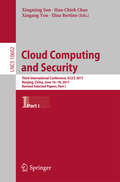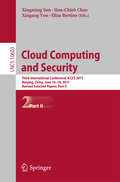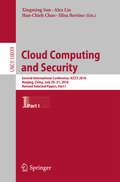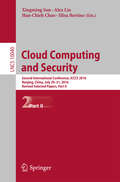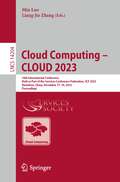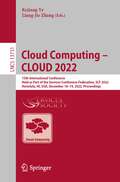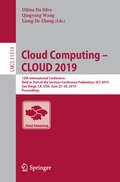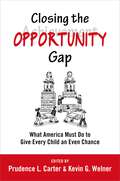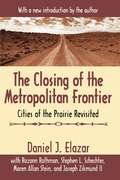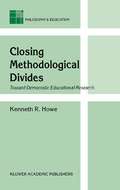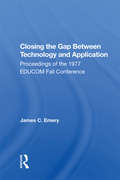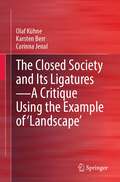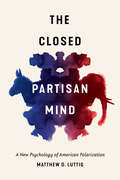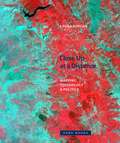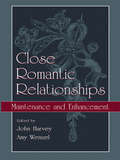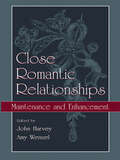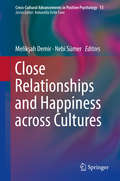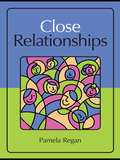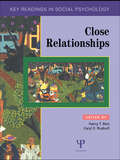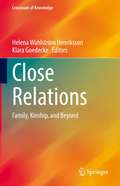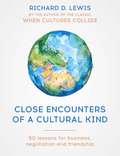- Table View
- List View
Cloud Computing and Security: Third International Conference, ICCCS 2017, Nanjing, China, June 16-18, 2017, Revised Selected Papers, Part I (Lecture Notes in Computer Science #10602)
by Xingming Sun Han-Chieh Chao Xingang You Elisa BertinoThis two volume set LNCS 10602 and LNCS 10603 constitutes the thoroughly refereed post-conference proceedings of the Third International Conference on Cloud Computing and Security, ICCCS 2017, held in Nanjing, China, in June 2017. The 116 full papers and 11 short papers of these volumes were carefully reviewed and selected from 391 submissions. The papers are organized in topical sections such as: information hiding; cloud computing; IOT applications; information security; multimedia applications; optimization and classification.
Cloud Computing and Security: Third International Conference, ICCCS 2017, Nanjing, China, June 16-18, 2017, Revised Selected Papers, Part II (Lecture Notes in Computer Science #10603)
by Xingming Sun Han-Chieh Chao Xingang You Elisa BertinoThis two volume set LNCS 10602 and LNCS 10603 constitutes the thoroughly refereed post-conference proceedings of the Third International Conference on Cloud Computing and Security, ICCCS 2017, held in Nanjing, China, in June 2017. The 116 full papers and 11 short papers of these volumes were carefully reviewed and selected from 391 submissions. The papers are organized in topical sections such as: information hiding; cloud computing; IOT applications; information security; multimedia applications; optimization and classification.
Cloud Computing and Security: Second International Conference, ICCCS 2016, Nanjing, China, July 29-31, 2016, Revised Selected Papers, Part I (Lecture Notes in Computer Science #10039)
by Xingming Sun Alex Liu Han-Chieh Chao Elisa BertinoThis two volume set LNCS 10039 and LNCS 10040 constitutes the thoroughly refereed post-conference proceedings of the Second International Conference on Cloud Computing and Security, ICCCS 2016, held in Nanjing, China, during July 29-31, 2016.The 97 papers of these volumes were carefully reviewed and selected from 272 submissions. The papers are organized in topical sections such as: Information Hiding, Cloud Computing, Cloud Security, IOT Applications, Multimedia Applications, Multimedia Security and Forensics.
Cloud Computing and Security: Second International Conference, ICCCS 2016, Nanjing, China, July 29-31, 2016, Revised Selected Papers, Part II (Lecture Notes in Computer Science #10040)
by Xingming Sun Alex Liu Han-Chieh Chao Elisa BertinoThis two volume set LNCS 10039 and 10040 constitutes the refereed post-conference proceedings of the Second International Conference on Cloud Computing and Security, ICCCS 2016, held in Nanjing, China, during July 29-31, 2016. The 97 papers of these volumes were carefully reviewed and selected from 272 submissions. The papers are organized in topical sections such as: Information Hiding, Cloud Computing, Cloud Security, IOT Applications, Multimedia Applications, Multimedia Security and Forensics.
Cloud Computing – CLOUD 2023: 16th International Conference, Held as Part of the Services Conference Federation, SCF 2023, Shenzhen, China, December 17–18, 2023, Proceedings (Lecture Notes in Computer Science #14204)
by Min Luo Liang-Jie ZhangThis book constitutes the refereed proceedings of the 7th International Conference on Cloud Computing, CLOUD 2023, held in Shenzhen, China, during December 17–18, 2023.The 5 full papers and 3 short papers in this book were carefully reviewed and selected from 13 submissions. The conference facilitates the exploration of emerging research areas and the shaping of the future landscape of cloud computing.
Cloud Computing – CLOUD 2022: 15th International Conference, Held as Part of the Services Conference Federation, SCF 2022, Honolulu, HI, USA, December 10–14, 2022, Proceedings (Lecture Notes in Computer Science #13731)
by Kejiang Ye Liang-Jie ZhangThis book constitutes the proceedings of the 15th International Conference on Cloud Computing, CLOUD 2022, held as part of the Services Conference Federation, SCF 2022, held in Honolulu, HI, USA, in December 2022. The 8 full papers and 1 short paper presented in this volume were carefully reviewed and selected from 15 submissions.The International Conference on Cloud Computing (CLOUD) has been a prime international forum for both researchers and industry practitioners to exchange the latest fundamental advances in the state of the art and practice of cloud computing, identify emerging research topics, and define the future of cloud computing. All topics regarding cloud computing align with the theme of CLOUD.
Cloud Computing – CLOUD 2019: 12th International Conference, Held as Part of the Services Conference Federation, SCF 2019, San Diego, CA, USA, June 25–30, 2019, Proceedings (Lecture Notes in Computer Science #11513)
by Qingyang Wang Liang-Jie Zhang Dilma Da SilvaThis volume constitutes the proceedings of the 12th International Conference on Cloud Computing, CLOUD 2019, held as part of the Services Conference Federation, SCF 2019, in San Diego, CA, USA, in June 2019. The 24 full papers were carefully reviewed and selected from 53 submissions. CLOUD has been a prime international forum for both researchers and industry practitioners to exchange the latest fundamental advances in the state of the art and practice of cloud computing, to identify emerging research topics, and to define the future of cloud computing. All topics regarding cloud computing align with the theme of CLOUD.
Closing the Opportunity Gap: What America Must Do to Give Every Child an Even Chance
by Prudence L. Carter Kevin G. WelnerWhile the achievement gap has dominated policy discussions over the past two decades, relatively little attention has been paid to a gap even more at odds with American ideals: the opportunity gap. Opportunity and achievement, while inextricably connected, are very different goals. Every American will not go to college, but every American should be given a fair chance to be prepared for college. In communities across the U.S., children lack the crucial resources and opportunities, inside and outside of schools that they need if they are to reach their potential. Closing the Opportunity Gap offers accessible, research-based essays written by top experts who highlight the discrepancies that exist in our public schools, focusing on how policy decisions and life circumstances conspire to create the "opportunity gap" that leads inexorably to stark achievement gaps. They also describe sensible policies grounded in evidence that can restore and enhance opportunities. Moving beyond conventional academic discourse, Closing the Opportunity Gap will spark vital new conversations about what schools, parents, educators, and policymakers can and should do to give all children a fair chance to thrive.
The Closing of the Metropolitan Frontier: Cities of the Prairie Revisited
by Daniel ElazarThe period from the mid-1960s to the early 1980s signaled the end of the prosperity of the postwar years enjoyed by the cities of the prairie-those cities located immediately within or adjacent to the Mississippi River drainage system, or what is usually called the American Heartland. During this period, the bottom dropped out of local economies and all collapsed except those upheld by massive state institutions. With this collapse, optimism for new opportunities ended, signaling the close of the American frontier.The Closing of the Metropolitan Frontier looks at mid-sized cities Champaign-Urbana, Decatur, Joliet, Moline, Peoria, Rockford, Rock Island, and Springfield, Illinois; Davenport, Iowa; Duluth, Minnesota; and Pueblo, Colorado. Elazar examines how they adapted to change during the period immediately after World War II, through the Vietnam War, and the Nixon years. He considers the roles of federal and state governments as instruments of change including their efforts to impose new standards and ways of doing business. The Closing of the Metropolitan Frontier analyzes the struggle between federalism and managerialism in the local political arena.In his new introduction, Daniel J. Elazar discusses this volume's place as part of a forty-year study of the cities of the prairie as well as the changes and developments in that region over that forty-year span. This volume will be of great interest to economists, political scientists, and sociologists interested in the Great Society and the New Federalism and their aftermath.
The Closing of the Metropolitan Frontier: Cities of the Prairie Revisited
by Daniel ElazarThe period from the mid-1960s to the early 1980s signaled the end of the prosperity of the postwar years enjoyed by the cities of the prairie-those cities located immediately within or adjacent to the Mississippi River drainage system, or what is usually called the American Heartland. During this period, the bottom dropped out of local economies and all collapsed except those upheld by massive state institutions. With this collapse, optimism for new opportunities ended, signaling the close of the American frontier.The Closing of the Metropolitan Frontier looks at mid-sized cities Champaign-Urbana, Decatur, Joliet, Moline, Peoria, Rockford, Rock Island, and Springfield, Illinois; Davenport, Iowa; Duluth, Minnesota; and Pueblo, Colorado. Elazar examines how they adapted to change during the period immediately after World War II, through the Vietnam War, and the Nixon years. He considers the roles of federal and state governments as instruments of change including their efforts to impose new standards and ways of doing business. The Closing of the Metropolitan Frontier analyzes the struggle between federalism and managerialism in the local political arena.In his new introduction, Daniel J. Elazar discusses this volume's place as part of a forty-year study of the cities of the prairie as well as the changes and developments in that region over that forty-year span. This volume will be of great interest to economists, political scientists, and sociologists interested in the Great Society and the New Federalism and their aftermath.
Closing Methodological Divides: Toward Democratic Educational Research (Philosophy and Education #11)
by K.R. HoweThis book is unique in the sweep of issues it considers and the way it integrates them under one general philosophical perspective. Vital reading for philosophers of education, educational researchers and social science methodologists.
Closing The Gap Between Technology And Application
by James C. EmeryThis book presents analyses, from three points of view, of the use of computing technology in higher education. It considers application areas including office automation, distributed academic computing, distributed administrative computing, instructional systems, and information resources.
Closing The Gap Between Technology And Application
by James C. EmeryThis book presents analyses, from three points of view, of the use of computing technology in higher education. It considers application areas including office automation, distributed academic computing, distributed administrative computing, instructional systems, and information resources.
The Closed Society and Its Ligatures—A Critique Using the Example of ‘Landscape’
by Olaf Kühne Karsten Berr Corinna JenalThe Closed Partisan Mind: A New Psychology of American Polarization
by Matthew D. LuttigThe Closed Partisan Mind traces the roots of partisan polarization to psychological closed-mindedness in the electorate and the changing perception of politics created by polarized political leaders and the new media environment. American politics today can be defined by the intense and increasingly toxic divide between Democrats and Republicans. Matthew D. Luttig explores why so many Americans have endorsed this level of political conflict.Luttig illustrates how the psychological need for closure leads people, regardless of whether they identify as Democrat or Republican, to express more polarized political attitudes. This association between closed minds and partisan polarization is a new phenomenon and can be traced to broader changes in American society, such as the creation of ideologically distinct political parties and a fragmented media environment. These developments have simplified politics into a black-or-white, us-versus-them conflict—making politics appeal to those with closed minds. Today, strong partisans do not just cheer for their political party to win elections. Instead, more akin to religious true believers, strong partisans use their affiliation as a means of understanding right and wrong, friend and enemy, true and false. The Closed Partisan Mind reveals that these dynamics have manifested in both a new type of partisanship and a new type of partisan. The emergence of this new closed partisanship illustrates the dangers that polarization has wrought on society, politics, and the minds of Americans.
Close Up at a Distance: Mapping, Technology, and Politics (Zone Bks.)
by Laura KurganThe past two decades have seen revolutionary shifts in our ability to navigate, inhabit, and define the spatial realm. The data flows that condition much of our lives now regularly include Global Positioning System (GPS) readings and satellite images of a quality once reserved for a few militaries and intelligence agencies, and powerful geographic information system (GIS) software is now commonplace. These new technologies have raised fundamental questions about the intersection between physical space and its representation, virtual space and its realization.In Close Up at a Distance, Laura Kurgan offers a theoretical account of these new digital technologies of location and a series of practical experiments in making maps and images with spatial data. Neither simply useful tools nor objects of wonder or anxiety, the technologies of GPS, GIS, and satellite imagery become, in this book, the subject and the medium of a critical exploration.Close Up at a Distance records situations of intense conflict and struggle, on the one hand, and fundamental transformations in our ways of seeing and of experiencing space, on the other. Kurgan maps and theorizes mass graves, incarceration patterns, disappearing forests, and currency flows in a series of cases that range from Kuwait (1991) to Kosovo (1999), New York (2001) to Indonesia (2010).Using digital spatial hardware and software designed for military and governmental use in reconnaissance, secrecy, monitoring, ballistics, the census, and national security, Kurgan engages and confronts the politics and complexities of these technologies and their uses. At the intersection of art, architecture, activism, and geography, she uncovers, in her essays and projects, the opacities inherent in the recording of information and data and reimagines the spaces they have opened up.
Close Romantic Relationships: Maintenance and Enhancement
by John H. Harvey Amy WenzelWith contributions from the leading experts on relationships, this book covers important issues, such as love as self-expansion, equity in maintaining close relationships, commitment, social support, self-verification, and minding the relationship. The end result is a comprehensive account of the reasons why close relationships are or are not maintained and the manner in which these principles can be applied to current social issues and clinical interventions. Divided into two sections, Part I describes models developed to characterize how relationships are maintained over time, accounts of specific mechanisms at work in close relationships, and conceptualizations of the maintenance and enhancement of close relationships using existing theoretical paradigms. Part II addresses contemporary social issues, as well as clinical applications. Close Romantic Relationships will appeal to students, researchers, and professionals due to its broad sampling of theory and research on relationship maintenance and enhancement.
Close Romantic Relationships: Maintenance and Enhancement
by John H. Harvey Amy WenzelWith contributions from the leading experts on relationships, this book covers important issues, such as love as self-expansion, equity in maintaining close relationships, commitment, social support, self-verification, and minding the relationship. The end result is a comprehensive account of the reasons why close relationships are or are not maintained and the manner in which these principles can be applied to current social issues and clinical interventions. Divided into two sections, Part I describes models developed to characterize how relationships are maintained over time, accounts of specific mechanisms at work in close relationships, and conceptualizations of the maintenance and enhancement of close relationships using existing theoretical paradigms. Part II addresses contemporary social issues, as well as clinical applications. Close Romantic Relationships will appeal to students, researchers, and professionals due to its broad sampling of theory and research on relationship maintenance and enhancement.
Close Relationships and Happiness across Cultures (Cross-Cultural Advancements in Positive Psychology #13)
by Melikşah Demir Nebi SümerThis volume focuses explicitly on close relationships as a reliable source for individual happiness and well-being across cultures. The work in this volume addresses theoretical issues and presents new cross-cultural data in the study of close relationships and happiness. Experts from different parts of the world provide in-depth, authoritative reviews and new findings on the relationship between various types of close bonds (e.g., intimate, marital, friendship, grandparent) and happiness in a variety of cultures. An ideal resource for researchers and students of relationship science and positive psychology, this rich, clear, and up-to-date book serves as an important reference for academicians in related fields of psychology such as cross-cultural, social, and developmental.
Close Relationships
by Pamela ReganThis multidisciplinary text introduces the concepts, methodologies, theories, and empirical findings of the field of interpersonal relationships. Information is drawn from psychology, communication, family studies, marriage and family therapy, social work, sociology, anthropology, the health sciences, and other disciplines. Numerous examples capture readers’ attention by demonstrating how the material is relevant to their lives. Active learning is encouraged throughout. Each chapter includes an outline to guide students, key terms and definitions to help identify critical concepts, and exploration exercises to promote active thinking. Many chapters include measurement instruments that students can take and score themselves. A website for instructors features a test bank with multiple-choice and essay questions and Power Points for each chapter. This text distinguishes itself with: Its focus on family and friend relationships as well as romantic relationships. Its multidisciplinary perspective highlighting the contributions to the field from a wide array of disciplines. Its review of the relationship experiences of a variety of people (of different age groups and cultures; heterosexual and homosexual) and relationship types (dating, cohabiting, marriage, friendships, family relationships). Its focus on methodology and research design with an emphasis on how to interpret empirical findings and engage in the research process. Cutting-edge research on "cyber-flirting" and online relationship formation; the biochemical basis of love; communication and social support; bullying and peer aggression; obsession and relational stalking; sexual violence (and marital rape); and grief and bereavement. The book opens by examining the fundamental principles of relationship science along with the research methods commonly used. The uniquely social nature of humans is then explored including the impact relationships have on health and well-being. Part 2 focuses on relationship development—from attraction to initiation to development and maintenance as well as the factors that guide mate choice and marriage. The development of relationships in both friendships and romantic partnerships is explored. Part 3 examines the processes that shape our interpersonal experiences, including cognitive (thinking) and affective (feeling) processes, communicative and supportive processes, and the dynamics of love and sex. The book concludes with relationship challenges—rejection and betrayal; aggression and violence; conflict and loss; and therapeutic interventions. Intended as a text for courses in interpersonal/close relationships taught in psychology, communication, sociology, anthropology, human development, family studies, marriage and family therapy, and social work, practitioners interested in the latest research on personal relationships will also appreciate this engaging overview of the field.
Close Relationships
by Pamela ReganThis multidisciplinary text introduces the concepts, methodologies, theories, and empirical findings of the field of interpersonal relationships. Information is drawn from psychology, communication, family studies, marriage and family therapy, social work, sociology, anthropology, the health sciences, and other disciplines. Numerous examples capture readers’ attention by demonstrating how the material is relevant to their lives. Active learning is encouraged throughout. Each chapter includes an outline to guide students, key terms and definitions to help identify critical concepts, and exploration exercises to promote active thinking. Many chapters include measurement instruments that students can take and score themselves. A website for instructors features a test bank with multiple-choice and essay questions and Power Points for each chapter. This text distinguishes itself with: Its focus on family and friend relationships as well as romantic relationships. Its multidisciplinary perspective highlighting the contributions to the field from a wide array of disciplines. Its review of the relationship experiences of a variety of people (of different age groups and cultures; heterosexual and homosexual) and relationship types (dating, cohabiting, marriage, friendships, family relationships). Its focus on methodology and research design with an emphasis on how to interpret empirical findings and engage in the research process. Cutting-edge research on "cyber-flirting" and online relationship formation; the biochemical basis of love; communication and social support; bullying and peer aggression; obsession and relational stalking; sexual violence (and marital rape); and grief and bereavement. The book opens by examining the fundamental principles of relationship science along with the research methods commonly used. The uniquely social nature of humans is then explored including the impact relationships have on health and well-being. Part 2 focuses on relationship development—from attraction to initiation to development and maintenance as well as the factors that guide mate choice and marriage. The development of relationships in both friendships and romantic partnerships is explored. Part 3 examines the processes that shape our interpersonal experiences, including cognitive (thinking) and affective (feeling) processes, communicative and supportive processes, and the dynamics of love and sex. The book concludes with relationship challenges—rejection and betrayal; aggression and violence; conflict and loss; and therapeutic interventions. Intended as a text for courses in interpersonal/close relationships taught in psychology, communication, sociology, anthropology, human development, family studies, marriage and family therapy, and social work, practitioners interested in the latest research on personal relationships will also appreciate this engaging overview of the field.
Close Relationships: Key Readings (Key Readings in Social Psychology)
by Harry T. ReisEach of the chapters in this reader is written by leading scholars in the area of relationships, reflecting the diversity of the field and including both contemporary and key historical papers for comprehensive coverage of research.
Close Relationships: Key Readings (Key Readings in Social Psychology)
by Harry T. Reis Caryl E. RusbultEach of the chapters in this reader is written by leading scholars in the area of relationships, reflecting the diversity of the field and including both contemporary and key historical papers for comprehensive coverage of research.
Close Relations: Family, Kinship, and Beyond (Crossroads of Knowledge)
by Helena Wahlström Henriksson Klara GoedeckeThis book speaks to the meanings and values that inhere in close relations, focusing on ‘family’ and ‘kinship’ but also looking beyond these categories. Multifaceted, diverse and subject to constant debate, close relations are ubiquitous in human lives on embodied as well as symbolic levels. Closely related to processes of power, legibility and recognition, close relations are surrounded by boundaries that both constrain and enable their practical, symbolical and legal formation. Carefully contextualising close relations in relation to different national contexts, but also in relation to gender, sexuality, race, religion and dis/ability, the volume points to the importance of and variations in how close relations are lived, understood and negotiated.Grounded in a number of academic areas and disciplines, ranging from legal studies, sociology and social work to literary studies and ethnology, this volume also highlights the value of using inter- and multidisciplinary scholarly approaches in research about close relations.Chapter 11 is available open access under a Creative Commons Attribution 4.0 International License via link.springer.com.
Close Encounters of a Cultural Kind: Lessons for business, negotiation and friendship
by Richard LewisRichard Lewis - world famous lecturer on intercultural issues and best-selling author of WHEN CULTURES COLLIDE - has collected 50 unique, critical cross-cultural incidents during his encounters in 135 countries around the globe. Some of these anecdotes are humorous, some are poignant, some are mysterious - all are insightful snapshots of the complex tapestry of cross-cultural business. If you're dining with a Finn, negotiating with the Japanese or attempting to climb a mountain with a team of diffident Italians, you need this book."Historically, 'cultural encounters' have often created wars and split people. In this precious little gem of a book, Richard shows how beautifully cultural barriers can be overcome when people meet face-to-face. How we, despite different outlooks, can build bridges across cultural gaps with mindful, respectful and humorous approaches. The stories, told in a vibrant and captivating voice, ranging from thought provoking and insightful to adventurous and hilarious, are a delightful read. The charming characters of broad cultural variety bring the whole world into your hands, making hearts bond over a jolly good laugh.And frankly, - what can be better?"Marit Imeland Gjesme, Founder of CultureCatch®, intercultural training consultancy
